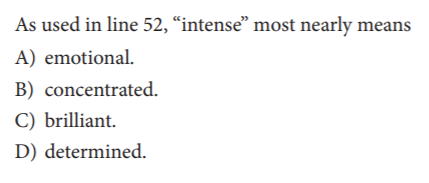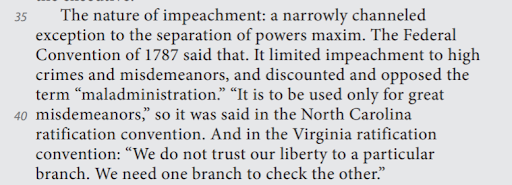Welcome back to Tricks of the Trade, where we guide you through all the ins and outs of standardized tests. Today we’ll be covering some of the most common questions you’ll encounter on the SAT Reading test: vocabulary in context (VIC). These questions are extremely easy to spot, as they always appear with exactly the same format:

Although VIC questions may seem simple and straightforward, they are designed in such a way that they can often appear to have more than one right answer. In other words, the answer choices are full of traps!
But don’t worry—using our method, you can avoid those sneaky trap answers with ease and dramatically improve your accuracy on these types of problems.
Step 1: Read the Question (and ONLY the Question)
The first VIC scenario you’ll see on SAT Reading is a common or easy word. You may see it and immediately think, “I know what that means—I don’t even need to look at the passage!” But just hold on a minute there, cowboy/cowgirl/cowperson. This is where the “in context” of “vocabulary in context” comes into play.
The second scenario you may come across is a word that you’ve never seen before (or maybe have seen but are unsure of its meaning). In this case, you may be thinking, “I have no idea what this word means. I’m gonna miss this question.” But again, remember that the “in context” aspect of VIC can also help to figure out the meanings of unknown words. The SAT is not a vocabulary test as much of a test of context clues.
So before jumping to any conclusions, force yourself to ignore the four answer choices. Looking at the answers before understanding the context of the passage may cause you to become biased toward a trap answer. You should approach the passage with a clean mental slate, which brings us to our next step.
Step 2: Fill in the Blank
Once you know the word you’re looking for and its line number, jump over to that sentence in the passage. Draw a physical line through the word and create your own “fill in the blank” question. Underline any words nearby that function as clues.
When making your own guess, don’t worry about finding the perfect replacement. You might only be able to come up with a phrase, which is completely fine! As long as your replacement has the correct meaning based on the context clues, you’ll be ready to head to the final step.
Step 3: Compare Your Prediction to the Answer Choices
Now it’s finally time to look at those answer choices. Take the prediction you made in the last step and compare it to each possible answer. If the ideas match, you’re in business. If not, cross off the choice and keep moving until you find the one that works.
Let’s look at an example and put our strategy into practice:
Step 1: We are looking for the meaning of “channeled”. This is a mid-level vocab word—you may have an idea of what it means, but we still need to check the context before moving on to the answers.
Step 2: Go to the line number from the question and create a “fill in the blank”. What we’re left with is, “The nature of impeachment: a narrowly _______ exception to the separation of powers maxim.” We find our clue words—in this case, “narrowly” shows us that the best word to fill in the blank should be something like “limited” or “restricted.”

Step 3: Now we can take our guess of “limited”/”restricted” and look at the answer choices.
- Choice A: “worn” is not a match with “limited.” Cross it off!
- Choice B: “sent” doesn’t match with “limited” either. Cross that off too!
- Choice C: “constrained” and “limited” are pretty close in meaning. We feel good about this answer, but let’s check the final choice to be sure.
- Choice D: you may or may not know what “siphoned” means. If you do know the meaning, you can cross it off because there’s no match here. If you don’t know the meaning, you don’t need to spend much time thinking about it since you’ve already found a match in choice C!
[Note: Don’t cross off an unknown word simply because it’s unknown. Always start with what you DO know, then make an educated guess regarding any unknown answer choices.]

We hope these tips will help you on your next SAT Reading test! Make sure to practice this strategy in a practice test or two to become comfortable making your own predictions and finding context clues. And don’t forget to schedule a call with one of our Student Success Advisors to get even more tips and tricks to help prepare you for your upcoming SAT!


